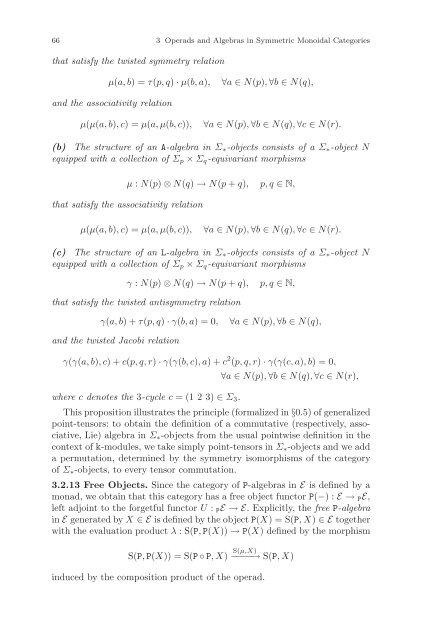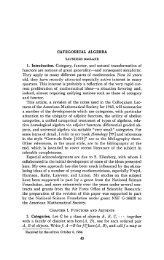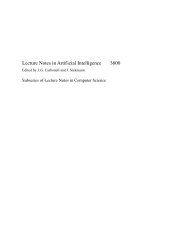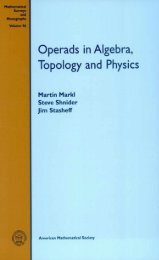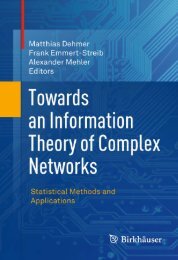Symmetric Monoidal Categories for Operads - Index of
Symmetric Monoidal Categories for Operads - Index of
Symmetric Monoidal Categories for Operads - Index of
You also want an ePaper? Increase the reach of your titles
YUMPU automatically turns print PDFs into web optimized ePapers that Google loves.
66 3 <strong>Operads</strong> and Algebras in <strong>Symmetric</strong> <strong>Monoidal</strong> <strong>Categories</strong><br />
that satisfy the twisted symmetry relation<br />
μ(a, b) =τ(p, q) · μ(b, a), ∀a ∈ N(p), ∀b ∈ N(q),<br />
and the associativity relation<br />
μ(μ(a, b),c)=μ(a, μ(b, c)), ∀a ∈ N(p), ∀b ∈ N(q), ∀c ∈ N(r).<br />
(b) The structure <strong>of</strong> an A-algebra in Σ∗-objects consists <strong>of</strong> a Σ∗-object N<br />
equipped with a collection <strong>of</strong> Σp × Σq-equivariant morphisms<br />
μ : N(p) ⊗ N(q) → N(p + q), p,q ∈ N,<br />
that satisfy the associativity relation<br />
μ(μ(a, b),c)=μ(a, μ(b, c)), ∀a ∈ N(p), ∀b ∈ N(q), ∀c ∈ N(r).<br />
(c) The structure <strong>of</strong> an L-algebra in Σ∗-objects consists <strong>of</strong> a Σ∗-object N<br />
equipped with a collection <strong>of</strong> Σp × Σq-equivariant morphisms<br />
γ : N(p) ⊗ N(q) → N(p + q), p,q ∈ N,<br />
that satisfy the twisted antisymmetry relation<br />
γ(a, b)+τ(p, q) · γ(b, a) =0, ∀a ∈ N(p), ∀b ∈ N(q),<br />
and the twisted Jacobi relation<br />
γ(γ(a, b),c)+c(p, q, r) · γ(γ(b, c),a)+c 2 (p, q, r) · γ(γ(c, a),b)=0,<br />
where c denotes the 3-cycle c =(123)∈ Σ3.<br />
∀a ∈ N(p), ∀b ∈ N(q), ∀c ∈ N(r),<br />
This proposition illustrates the principle (<strong>for</strong>malized in §0.5) <strong>of</strong> generalized<br />
point-tensors: to obtain the definition <strong>of</strong> a commutative (respectively, associative,<br />
Lie) algebra in Σ∗-objects from the usual pointwise definition in the<br />
context <strong>of</strong> k-modules, we take simply point-tensors in Σ∗-objects and we add<br />
a permutation, determined by the symmetry isomorphisms <strong>of</strong> the category<br />
<strong>of</strong> Σ∗-objects, to every tensor commutation.<br />
3.2.13 Free Objects. Since the category <strong>of</strong> P-algebras in E is defined by a<br />
monad, we obtain that this category has a free object functor P(−) :E→ PE,<br />
left adjoint to the <strong>for</strong>getful functor U : PE →E. Explicitly, the free P-algebra<br />
in E generated by X ∈Eis defined by the object P(X) =S(P,X) ∈Etogether<br />
with the evaluation product λ :S(P, P(X)) → P(X) defined by the morphism<br />
S(P, P(X)) = S(P ◦ P,X) S(μ,X)<br />
−−−−→ S(P,X)<br />
induced by the composition product <strong>of</strong> the operad.


